Few places in Scotland capture the raw drama of land meeting sea like Neist Point, the westernmost tip of the Isle of Skye. Perched on a rugged headland that juts defiantly into the Atlantic, Neist Point Lighthouse has become an icon for photographers, hikers, and dreamers alike. Visiting this spot is not just a journey—it’s an experience that blends natural grandeur, maritime history, and a dash of adventure.
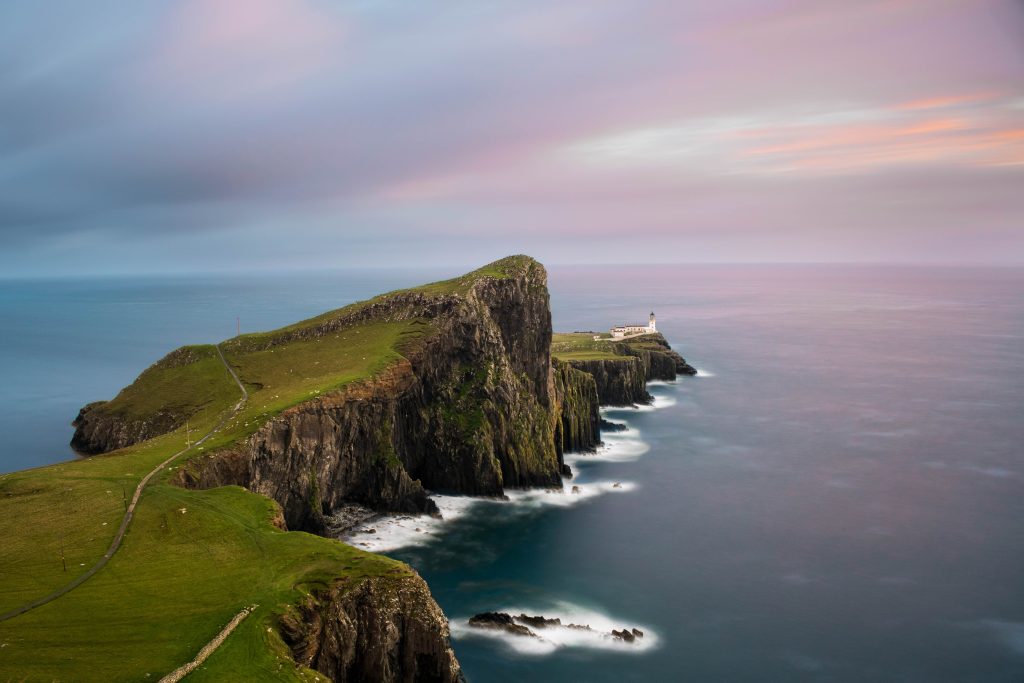
The Road to the Edge
The drive to Neist Point begins with promise: winding single-track roads through Skye’s moorlands, where sheep graze freely and mountains loom in the distance. The landscape feels elemental—rock, grass, and sky in endless conversation. As you near the township of Glendale, the road narrows further, curling toward the cliff-lined coast. Here, patience becomes your best travel companion. Passing places punctuate the route, reminders that this is not a highway but a shared ribbon of asphalt threading through wilderness.
First Glimpse of the Lighthouse
Arriving at the car park, the view steals your breath. Below, the headland arcs into the sea like a green dragon’s tail, its spine rising to sheer cliffs that plunge into foaming surf. At the far tip stands Neist Point Lighthouse, a white sentinel built in 1909 to guide ships through the treacherous waters of the Minch. Its design is classic Stevenson—functional yet elegant, a testament to Scotland’s engineering heritage.
The walk to the lighthouse is about a mile, descending steep steps before leveling out along a concrete path. Every turn offers a new perspective: cliffs streaked with basalt, seabirds wheeling overhead, and the Atlantic stretching to infinity. On calm days, the sea glows sapphire; in storm, it roars steel-grey, hurling spray against the rocks.
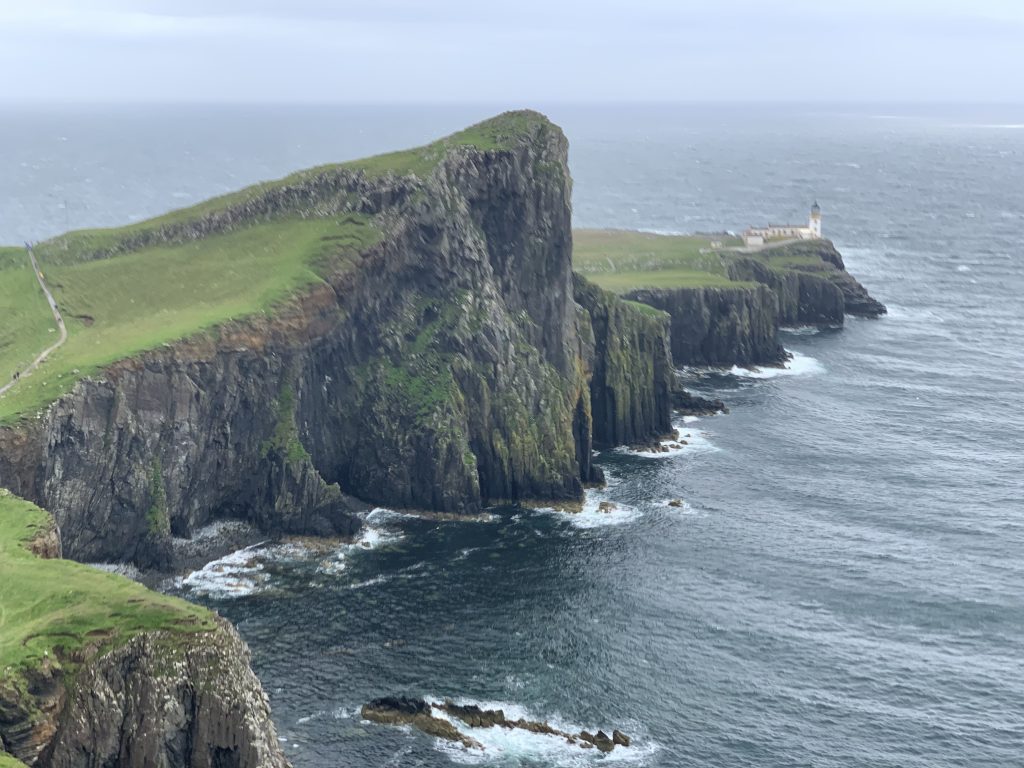
Wildlife and Wonder
Neist Point is a haven for wildlife. Look for gannets and fulmars riding the updrafts, and if luck smiles, you might spot minke whales or dolphins in the waters below. The cliffs host nesting seabirds, and the surrounding moorland blooms with wildflowers in summer. For photographers, golden hour here is pure magic—the lighthouse bathed in amber light, the sea shimmering like molten glass.
A Place of Stories
Beyond its beauty, Neist Point carries whispers of history. The lighthouse, automated since 1990, once housed keepers who braved isolation and Atlantic gales. Their cottages still stand, weathered but stoic, echoing lives lived on the edge of the world. Folklore clings to these cliffs too—tales of shipwrecks, selkies, and spectral lights dancing on stormy nights. Whether you believe or not, the setting makes such stories feel plausible.
Practical Tips for Visiting
- Getting There: From Dunvegan, follow signs for Glendale and Neist Point. The last stretch is single-track—drive slowly and use passing places.
- Parking: A small car park sits at the trailhead. In summer, it fills quickly; arrive early or late for space and solitude.
- Footwear: Sturdy shoes are essential. The path is steep in places and can be slippery after rain.
- Weather: Skye’s weather changes fast. Pack layers and waterproofs—even on sunny mornings.
- Facilities: None at the point. Bring water and snacks; the nearest cafés are back in Glendale.
The Return Journey—and a Lesson in Patience
After hours of sea air and cliff-edge wonder, you head back toward civilization, heart full and camera brimming. The single-track road unwinds like a ribbon through moor and glen. You’re replaying the day in your mind—the lighthouse gleaming against the Atlantic, the hush of waves far below—when suddenly, the car slows. Then stops.
Ahead, two travel RVs face each other like stubborn stags in rut, locked in a stand-off on the narrow road. Both have already passed a passing place, and neither can reverse easily. Behind them, a queue of cars snakes across the moor, engines idling, drivers craning necks. The scene is almost comic: two gleaming motorhomes, each bristling with bikes and roof boxes, frozen in mutual disbelief.
Minutes stretch. A driver steps out, gesturing with the universal language of exasperation. Another consults a map as if cartography might conjure a solution. Sheep look on, unimpressed. The wind carries fragments of conversation—“I can’t reverse that far!” “Well, neither can I!”—punctuated by sighs and the occasional slam of a door.
Eventually, after what feels like an eternity (but is probably twenty minutes), diplomacy prevails. One RV begins the slow, nerve-jangling reverse toward the last passing place, its partner inching forward with theatrical caution. The queue exhales as cars creep past, drivers offering sympathetic smiles or wry shrugs. When your turn comes, you roll by with a wave, resisting the urge to applaud.
Why This Moment Matters
It would be easy to file this under “travel annoyances,” but in truth, it’s part of the Hebridean experience. These roads were not built for modern motorhomes; they were stitched across moorland for crofters and cattle, long before tourism swelled. Their narrowness enforces a kind of etiquette—a reminder that in places like Skye, speed and convenience bow to landscape and community.
That traffic jam becomes a story you’ll tell, a footnote to the grandeur of Neist Point. It underscores a truth every traveler learns: beauty often comes with inconvenience, and sometimes the best memories sprout from the unexpected. You came for a lighthouse and left with a tale of two RVs, a lesson in patience, and a renewed respect for the fragile choreography of single-track roads.
Final Thoughts
Visiting Neist Point Lighthouse is not just about ticking a landmark off your list. It’s about standing at Scotland’s western edge, feeling the Atlantic wind on your face, and glimpsing a world where nature still calls the shots. It’s about the long road there and the longer road back, where even a traffic jam can become a chapter in your adventure. So go—walk the headland, watch the sea, and when you meet an RV on a single track, smile. You’re part of the story now.
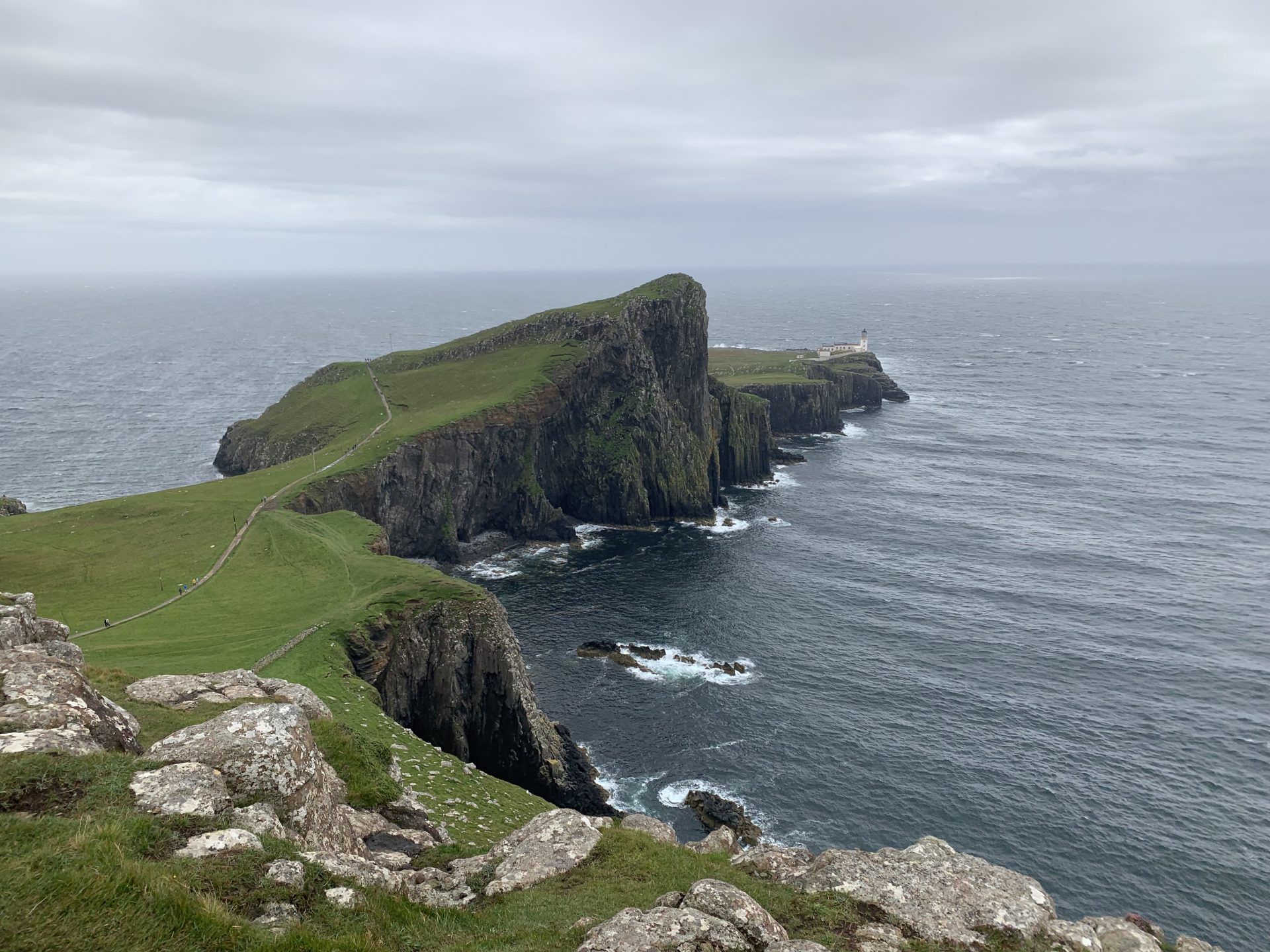
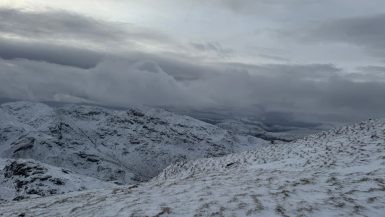
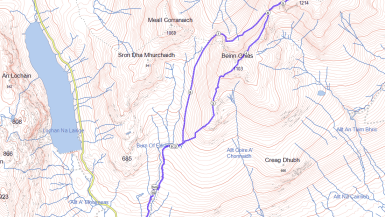
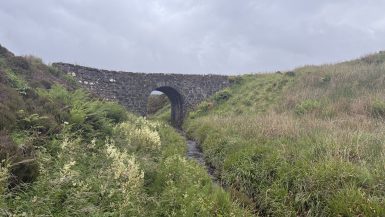
Leave a reply
You must be logged in to post a comment.